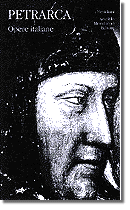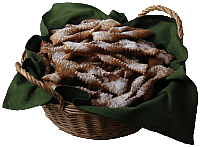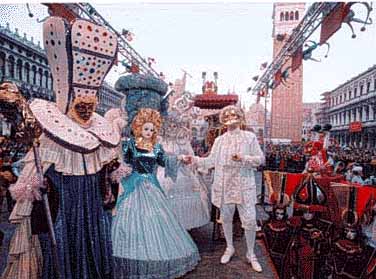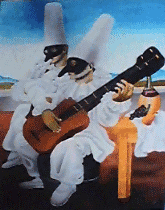Francesco Petrarca
Carnevale in Italia
Crostoli
La Rondine is published monthly by The Italian Club of St. Louis
President
Franco Giannotti
Internet Edition

|
|
|
|
|
|
February Meeting
I PARTIGIANI
| The February program will be special in many ways. The presenters are
one of our own members, Valerio Bianco, and Harry Burger
(alias Lt. Biancastella), author of the book Biancastella: A Jewish
Partisan in World War Two.
Both of these men, as teenagers, were partigiani (partisan fighters) in Italy, fighting against the Nazis and for their country. Italian partisans put their lives at great risk to free Italy from Nazi domination and to aid the Allies. Their very youth must have helped them stay alive and do their duty but that youth was lost too soon and too quickly. To quote Mr. Burger's book: "More than my name changed during the war. I had grown up in a well-to-do family: my father owned a very successful textile company and I was being groomed to take over the family business. I was fourteen when the war began, twenty-one by the time it was over, and in those years the prospects for my future were forever altered. I became not the man I hoped to be but the man I had to be." I believe this is true of Valerio Bianco also. Who would wish to be a killer and a fugitive as a teenager? These men had to grow up fast and furiously. The format of the program is a new one for us. I will be an interviewer and facilitator for these two men, asking questions and perhaps giving direction. But Harry and Valerio are the true presenters. They will take us where they wish to go and tell us what they want to tell us. It is their program and their lives that we are interested in. What motivated them to become a partisan? What did their families think? What did they do for supplies? How effective do they think the partisans were in slowing down the Nazi machine? Are they still in touch with any of their fellow partigiani? These are only some of the questions we can and might ask. Come and honor these men whose courage and love of family, of their people, and of life itself moved them to put their lives on the line at a very young age. (Roger Gennari) |
|
|
Recap of January Meeting
|
New Officers and Board Members were introduced and installed into office: President: Gene Mariani The Committee Chairpersons were introduced: Program Committee: Roger Gennari, Pete Puleo, Tony Perrone, Vito Tamboli, Patty Viviano and Gene Mariani Election of a new member: Chester Pedroli's application was presented to the membership. A motion was made and seconded and a vote was taken to accept Mr. Pedroli. Welcome, Chester! Annales of 1998: Reports and comments on the state of the Italian Club. (Ed. Note: The forum is found at //forum.htm)
Future Plans
Open Discussion Question and Answer Period |
|
The evening concluded with the membership playing Tombola, brought to us by Barbara Klein. Audrey Giovanni was the Tombola winner and received a bottle of wine as a prize |
The Italian Radio Hour Completes Its Second Year
| In February, the Italian Radio Hour celebrates its second anniversary and congratulations are in order for Italian Club members Charles and Josephine Barrale, the driving forces behind the program. Since its initiation by the St. Louis Bocce Club, the program has been produced and directed by Chuck and Jo. The Italian Radio Hour has an interesting format in that each show features a different Italian-speaking "host." Italian Club members who have contributed their time and talent by volunteering as program hosts include Dante Marconi, Tony Perrone, Geri Hoff, Maria Grazia Hayes, Vito Tamboli, Roger Gennari - and, once, even Gene Mariani. In addition to presenting widely ranging selections of Italian music, popular as well as operatic and classical, each program features interesting and informative guest interviews, in English or Italian, with prominent members of the Italian-American community of St. Louis. The Italian Radio Hour may be heard every Sunday afternoon from 1:00 to 3:00 PM on station WEW at 770 AM. |
L'angolo del presidente
by Gene Mariani
| DINNER COST TO BE $17
Commencing with the February meeting, the charge for dinner will be increased to $17.00. The previous charge of $15 has been in effect for several years and the Board strongly felt that, on an overall basis, the price increase would be both fair and reasonable. In conjunction with the increase two improvements will be made: first the paper table coverings will be replaced with cloth coverings; second, unlimited wine will be served with dinner at no extra charge. As always, the entire price of the meal goes directly to the restaurant; the Club makes no money whatsoever on the meal charge. On behalf of the Board, I want to thank Baldo Gandolfo, a member of the Club, and Madda as well, for the cooperation and consideration which they have always extended to the Italian Club.
At the beginning of our January Annales meeting, the new Officers and Directors elected this past October were introduced to the membership. Unfortunately, one important element was inadvertently omitted and that was to recognize retiring Director Norman Merlotti for his six years of service as a member of the Board. I cannot adequately thank Norman, and of course Rose as well, for their kindness, hard work, loyalty, and dedication to the Club and its members for many years
A warm welcome is enthusiastically extended to new member Chester
Pedroli and his wife Eileen. ITALIAN CLUB HOME PAGE Also at the January meeting, Franco Giannotti, originator of the Club's internet home page and the Club's official webmaster, presented an interesting and informative report on the activity of our site during the past year. Our home page is an important asset and I would like to thank Franco, once again, for his contribution. The website provides direct on-line access to our newsletter, La Rondine, as well as links to a number of Italian sites including newspapers, magazines, and other sources of cultural information. Members having internet access are urged to check our home page frequently. If you are a member having email capability, please send me your email
address so I can put you on our distribution list. My address is emariani@aol.com
Each year at the June meeting, the Club presents its Italian Heritage Award to an individual who has distinguished himself or herself through community service. It is not too early to start thinking about possible candidates. Members who would like to nominate someone are asked to send their nomination, in writing, to me or to the Club Secretary Marie Cuccia-Brand, including a brief explanation giving the reasons why you think the person should receive the award. |
I capolavori della poesia italiana
6. Il capolavoro di Francesco Petrarca (Arezzo 1304 - Arquà
1374) è il  Canzoniere,
la raccolta di componimenti lirici in lingua volgare che il poeta compose
durante tutta la sua vita. In esso Petrarca diede l'espressione più
limpida e raffinata dell'amore e della capacità di elevazione dell'uomo
e delle sue inquietudini e ambiguità, sia spirituali che psicologiche,
precorrendo le forme e il linguaggio della lirica moderna. Elemento ispiratore
e tema fondamentale dell'opera è l'amore per Laura, incontrata ad
Avignone il giorno 6 aprile 1327. In questo sonetto Petrarca rievoca il
tempo della prima giovinezza di Laura. Canzoniere,
la raccolta di componimenti lirici in lingua volgare che il poeta compose
durante tutta la sua vita. In esso Petrarca diede l'espressione più
limpida e raffinata dell'amore e della capacità di elevazione dell'uomo
e delle sue inquietudini e ambiguità, sia spirituali che psicologiche,
precorrendo le forme e il linguaggio della lirica moderna. Elemento ispiratore
e tema fondamentale dell'opera è l'amore per Laura, incontrata ad
Avignone il giorno 6 aprile 1327. In questo sonetto Petrarca rievoca il
tempo della prima giovinezza di Laura. |
|
Il carnevale in Italia
| Febbraio è il mese del Carnevale, il periodo che precede la
Quaresima, dedicata alla penitenza per la preparazione alla Pasqua. A Carnevale
è permesso ogni tipo di divertimento e gli eccessi nel mangiare
e nel divertirsi sono scontati. Questa pratica, che deriva da antiche usanze
pagane come i saturnali e i lupercali, in certi luoghi ha inizio a Capodanno,
in altri all'Epifania e in altri ancora alla Candelora (2 febbraio) e culmina
nei giorni definiti grassi (dal giovedì al martedì
prima delle Ceneri).
Viene festeggiato ovunque con balli, corsi mascherati e divertimenti
vari. Al Tipici dolci di carnevale sono i crostoli veneziani, altrove chiamati anche chiacchiere, cenci o frappe. Le varie manifestazioni che si svolgono a Carnevale hanno reso famose alcune città, tra cui Venezia, Viareggio e Acireale. |
OPERE DI ITALIANI AL MUSEO DI ST. LOUIS
21. Bernardo Strozzi. San Lorenzo. (Olio su tela, circa 1625)
| Detto il Cappuccino o il Prete Genovese, Bernardo Strozzi
(Genova 1581-Venezia 1644) ebbe una vita molto avventurosa e da giovane
fu il più importante esponente della scuola genovese. A Genova aveva
conosciuto i capolavori dei grandi pittori fiamminghi Rubens e Van Dyck
ed aveva raggiunto uno stile originale interpretando la drammaticità
e l'uso della luce di Caravaggio. Nel 1630, a causa di una lite con i frati
Cappuccini, dovette fuggire a Venezia dove lo studio delle opere dei pittori
veneziani arricchì il suo stile e lo rese uno dei grandi pittori
del secolo.
Fu anche celebre ritrattista, come lo dimostrano il Ritratto del doge Erizzo, e il Ritratto di un cavaliere di Malta. Pare che il soggetto di San Lorenzo che dona ai poveri i tesori della chiesa gli fosse molto caro perché lo dipinse in varie versioni, di cui questo quadro nel museo di St. Louis è una delle migliori. I colori delicati e vibranti, i giochi di luce e ombra che danno rilievo alle figure e alla narrativa, gli oggetti preziosi in primo piano, stupendamente illustrati in tutti i loro dettagli, contribuiscono a fare di questo olio un vero capolavoro. San Lorenzo era un diacono sotto Papa Sesto II, che fu condannato a morte dall'imperatore Valeriano nel 259 A.C. Prima di morire, il papa diede a Lorenzo i tesori della chiesa e così facendo causò il suo martirio. Infatti più tardi Lorenzo fu bruciato a fuoco lento sulla graticola per aver rifiutato di consegnare al prefetto i tesori della comunità. Questi tesori sono gli oggetti più vicini a chi guarda e servono a guidare lo sguardo verso l'interno del dipinto, mentre l'incensiere che il santo tiene in mano forse allude al suo martirio. |
I PIATTI DI CARNEVALE
|
I crostoli di Venezia  |
|
Mescolare, mettere l'impasto a fontana e rompervi le uova intere, il burro ammorbidito a pezzetti e il Marsala. Stenderlo con il mattarello come la sfoglia delle tagliatelle. Con la rotellina dentata, ricavare dei rettangoli di circa 8 x 12 cm. e farvi 3 tagli verticali, lasciando unite le estremità. Friggere i crostoli a due o tre per volta nell'olio bollente.
|
|
|

 Carnevale
sono legate alcune maschere tipiche, caricature di vizi e difetti degli
abitanti delle varie regioni. Tra le più famose ricordiamo Pulcinella,
tipica maschera napoletana; che ha la gobba e il naso adunco e veste con
camiciotto e pantaloni bianchi ed una mascherina nera; Arlecchino,
maschera veneziana con un tipico costume a rombi multicolori, servo sciocco
e loquace, ma molto furbo; Pantalone, altra maschera veneziana,
vecchio mercante pedante ed avaro, che non disdegna le avventure galanti;
Balanzone, la maschera tipica di Bologna, dottore saccente e ciarliero.
Carnevale
sono legate alcune maschere tipiche, caricature di vizi e difetti degli
abitanti delle varie regioni. Tra le più famose ricordiamo Pulcinella,
tipica maschera napoletana; che ha la gobba e il naso adunco e veste con
camiciotto e pantaloni bianchi ed una mascherina nera; Arlecchino,
maschera veneziana con un tipico costume a rombi multicolori, servo sciocco
e loquace, ma molto furbo; Pantalone, altra maschera veneziana,
vecchio mercante pedante ed avaro, che non disdegna le avventure galanti;
Balanzone, la maschera tipica di Bologna, dottore saccente e ciarliero.